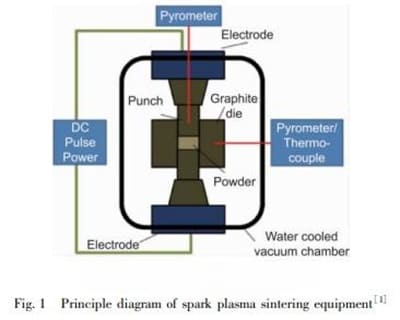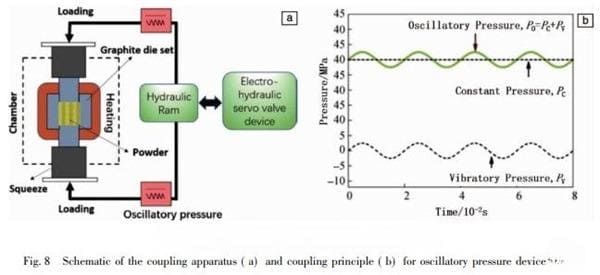Ceramic materials are important for engineering and various applications, including new energy, communications, electronics, semiconductors, and aerospace. However, traditional ceramic sintering processes can lead to grain coarsening and porosity, affecting material performance. To address this, researchers have developed new sintering techniques to lower temperatures, reduce processing time, and improve ceramic density and performance.
Spark Plasma Sintering (SPS)
SPS technology is different from traditional sintering methods. It uses high electric current to generate heat instead of relying on a heating element. Graphite is commonly used as the mold material for insulating samples, while an insulating mold is used for conductive samples. The heating rate can be as high as 1000 ℃/min, and a short holding time is enough for sintering.
SPS technology has several outstanding advantages, including low sintering temperature, short holding time, fast heating rate, adjustable sintering pressure, and the ability to achieve multi-field coupling (electric-power-thermal)

Flash Sintering (FS)
Researchers have discovered a new sintering technique called "flash sintering" (FS), which allows for rapid low-temperature sintering of materials under specific temperature and electric field conditions. In comparison to traditional sintering methods, FS offers several advantages. Firstly, it significantly shortens the sintering time and reduces the required furnace temperature. Secondly, it helps to suppress grain growth and enables non-equilibrium sintering. Additionally, FS is characterized by its simplicity in equipment and lower cost.
Cold Sintering (CS)
Ceramic CS is different from traditional high-temperature sintering. It involves adding an instant solvent to the powder and applying high pressure (350-500 MPa) to enhance particle rearrangement and diffusion. This allows the ceramic powder to achieve densification at lower temperatures (120-300 °C) and shorter times. It enables the production of high-performance structural and functional ceramics through low-temperature sintering.
The CS (Conventional Sintering) process is influenced by various factors such as particle size, water solution amount, particle solubility, pressure, temperature, holding time, and subsequent heat treatment temperature. Despite these influences, the equipment used for this technology is relatively simple.
Oscillatory Pressure Sintering (OPS)
A new design concept called OPS (Oscillating Pressure Sintering) has been developed internationally. OPS technology and equipment are used to introduce dynamic oscillating pressure instead of the traditional constant static pressure in the powder sintering process. OPS applies a constant pressure along with adjustable frequency and amplitude of oscillating pressure. This transforms the static force used in traditional sintering into a dynamic force.

The densification of materials during the OPS (Oscillating Pressure Sintering) process is mainly attributed to two mechanisms:
- Traditional mechanisms involve grain boundary diffusion, lattice diffusion, and evaporation-condensation under the influence of surface energy.
- New mechanisms are induced by oscillating pressure, including particle rearrangement, grain boundary sliding, plastic deformation, grain movement caused by deformation, and elimination of pores.

OPS technology provides unique advantages in the preparation of materials with near theoretical density, low defects, and ultrafine grain microstructures. It offers a new method for improving the actual fracture strength and reliability of structural ceramics and hard alloy materials.
Heeger Materials is a reputable supplier offering top-notch Technical Ceramics products at competitive prices, which are widely used in research and science fields. If you're interested, feel free to contact us at [email protected] for a quote, and we guarantee a response within 24 hours.


